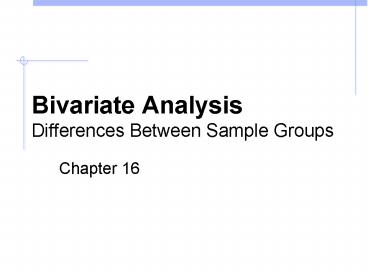Bivariate Analysis Differences Between Sample Groups - PowerPoint PPT Presentation
1 / 18
Title:
Bivariate Analysis Differences Between Sample Groups
Description:
Bivariate statistical analysis: the analysis of relationships (e.g., differences) ... Bivariate Analysis: Differences in Means and Proportions. Standard Error ... – PowerPoint PPT presentation
Number of Views:130
Avg rating:3.0/5.0
Title: Bivariate Analysis Differences Between Sample Groups
1
Bivariate AnalysisDifferences Between Sample
Groups
- Chapter 16
2
Bivariate Cross-Tabulation
- Bivariate statistical analysis the analysis of
relationships (e.g., differences) between two
variables - Chapter overview
- T-test of differences in means of two independent
samples - One-way analysis of variance (ANOVA) for k groups
- Two-way ANOVA of differences in between two
variables and within the k groups defining each
of the variables
3
(No Transcript)
4
Application
Research Question Is occupational status
associated with the loyalty status? Means of
analysis Chi-square compute theoretical
frequencies for each cell on the null hypothesis
that loyalty is statistically independent of
occupation. Degrees of freedom (R-1)(C-1).
Significance level 0.05
5
Computer Programs for Cross-Tabulation
- Most programs provide
- Computations of row and column percentages
- Introduction of a third variable to describe
association between a pair of variables - Determination of a statistical significance of
the association observed - Measurement of the strength of the association by
means of an agreement index
6
Bivariate Analysis Differences in Means and
Proportions
- Standard Error of Differences
- SE of Difference in Means
- If the population stdev are not known, they must
be estimated. - SE of Difference in Proportions
7
Testing of Hypotheses
- When applying the SE formulas, the following
conditions must be met - Samples must be independent
- Individual items in samples must be drawn in a
random manner - The population being sampled must be normally
distributed (or sample size sufficiently large) - For small samples, the population variances must
be equal - The data must be at least intervally scaled
8
Testing of Hypotheses (cont.)
- Steps
- Specify the null hypothesis
- Establish the level of statistical significance
- a 0.05
- a) Calculate the Z-value
- Means
- Proportions
9
Testing of Hypotheses (cont.)
- 3. b) For unknown population variance and small
samples, the Student t distribution must be used. - 4. Determine the probability of the observed
difference of the two sample statistics having
occurred by chance. (tables) - 5. If the probability of the observed difference
is greater than the alpha risk, accept the null
hypothesis if the opposite, reject the null
hypothesis.
10
Testing the Means of Two Groups The Independent
Samples t-Test
- When testing variances in large samples
- Pooled variance estimate
- When testing for the same population proportion
in two populations - Testing the difference in means between two small
samples
11
Testing of group means ANOVA
- t-Test tests differences between two group means
- ANOVA tests the overall difference in k group
means, where the k groups are thought as levels
of a treatment or control variable(s) or
factor(s). - The variables influencing the results are called
experimental (control) factors. - Control factors in agriculture seed type,
fertilizer type, fertilizer dosage, temperature,
moisture, etc. - ANOVA tests the statistical significance of
differences in mean responses given the
introduction of one or more treatment effects.
12
ANOVA Methodology
- ANOVA designs
- Total sum of squares
- Between-treatment sum of squares
- Within-treatment sum of squares
- Compares the between-treatment-groups sum of
squares with the within-treatment-group sum of
squares ? F statistic - F statistic indicates the strength of the
grouping factor the larger the ratio of between
to within, the more inclined to reject Ho. - If the variance of the error distribution is
large relative to differences among treatments,
the true effects may be swamped ?Accept Ho when
it is false
13
One-way (single factor) ANOVA
14
One-way (single factor) ANOVA
15
Follow-up Tests of Treatment Differences
- F-ratio only provides information that
differences exist. Then which treatments differ? - To find out, perform a follow-up analysis series
of independent sample t-tests. - Ex Bonnferonis test, Duncans multiple range
tests, Scheffes test, etc. - These test statistics control the probability
that a Type I error will occur when a series of
statistical test are conducted.
16
N-Way (Factorial) ANOVA Designs
- Factorial experiment an equal number of
observations is made of all combinations
involving at least two levels of at least two
variables. - Enables researchers to study possible
interactions among the variables of interest. - These Interactions can be ordinal and disordinal.
- Note Response increments differ, line segments
are not parallel. (differential effect)
17
(No Transcript)
18
Nonparametric Analysis
- Other tests
- Wilcoxon Rank Sum
- Mann-Whitney
- Kolmogorov-Smirnov
- Indexes of Agreement
- Chi-square
- 2x2 Case (phi correlation coefficient)
- RxC Case (contingency coefficient)

